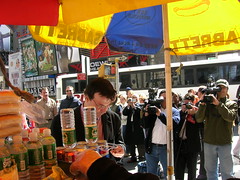
PREV ARTICLE
NEXT ARTICLE
FULL ISSUE
PREV FULL ISSUE
COIN DROP STUNT BACKLASH
Donn Pearlman of Las Vegas, Nevada submitted these thoughts on the usefulness of the "coin drop" stunt for coin show publicity.
-Editor
I enjoyed reading the article in the December 6, 2009 edition (v12#49), "Ideal Coin Show Publicity: Houston Coin Club," about promoting the show with the exhibit of a 1943 bronze cent. After 30 years of helping to promote various coin shows (and 30 years of working in the print and broadcast news media prior to turning to The Dark Side of the Force -- PR), I've learned this: You have to give the non-collecting public a solid reason to get off the couch and come to the show. I used to believe that a "coin drop" stunt -- deliberately placing a rare coin into circulation -- was a way to do that. But now I discourage that kind of promotion. At the 1992 ANA convention in Orlando, Florida, someone from (what was then) Krause Publications was handling the coin drop and arranged for a TV news crew to follow him as he made a purchase using a rare coin as part of the pocket change. However, the TV crew was never taken into the coin show! The coin dropper met them outside a nearby hotel. So, the TV coverage that night was only about a rare coin in change in the Orlando area with no video of the coin show! It was then I realized that you need a compelling reason for the general public to come to the show. A rare coin in circulation may prompt them to closely look at their pocket change, but probably won't get them in the door unless they find it or are spurred to bring in Grandpa's old coins stored in a tin can. You need something that will attract larger numbers of people, and that's usually A) an eye-opening exhibit such as a six-figure 1943 bronze cent or the BEP's $100,000 bills or the SS Central America Ship of Gold display (which, by the way, is coming out of dry dock and will be at the February Long Beach Expo) and/or B) free appraisals of old coins and bank notes. Even the best, widely-promoted come-and-see-it exhibit, though, can be thwarted by bad weather on the show days or an inconvenient location for the public to visit. And, despite my don't-do-a-coin-drop mantra for promoting shows, I happily used coin drops in April 2006 to simultaneously promote National Coin Week and a new edition of Scott Travers' book, "The Coin Collector's Survival Manual."


Photos used with permission of Donn Pearlman. All rights reserved. Scott used rare coins to purchase some items from push cart vendors in midtown Manhattan. The New York Times ran a story that promoted National Coin Week and the book, and we had representatives of virtually every local TV station and news network cover one of the coin drops. Most of them, too, mentioned both National Coin Week and Scott's book in their subsequent coverage. Here's a photo of Scott showing the news media the 1909-S V.D.B. Lincoln cent he was about to use with other loose change to buy a bottle of water from an unsuspecting vendor a block away. Now you ask, "How could he be an unsuspecting vendor with all the TV cameras following him?" Remember, this was in Times Square. People who live and work there are used to seeing camera crews for television and movies. And when this particular vendor noticed the cameras as Scott was making his purchase, I simply told him, "I think he's some personality from Canada....."
I'm glad to hear others agree that the "coin drop" stunt has outlived its usefulness. I did it once, spending a 1914-D Lincoln Cent in downtown Pittsburgh to help advertise a Pennsylvania Association of Numismatists show. We did generate a good bit of publicity, but I don't think I would do it again.
-Editor
Regarding the 1943 copper cent, Don Cleveland adds: Your recent article in E-Sylum about 1943 copper one cent coins reminds me of my high-school chemistry class. My friends and I, who were enrolled in the Lebanon, Oregon, high-school's chemistry class back in the late 1950s, found we could use electrolysis to copper coat the "white" 1943 "pennies" which still circulated in those days. Utilizing a solution made from copper sulfate, we plated a couple of rolls of these coins. We eventually passed the coins into circulation in the local area. I believe students in nearby Sweet Home and Albany, Oregon, schools (and probably all across the U.S.) also produced a few. They are easily identified: their steel cores still react to a magnet. To read the earlier E-Sylum article, see: IDEAL COIN SHOW PUBLICITY: HOUSTON COIN CLUB (www.coinbooks.org/esylum_v12n49a20.html) THE BOOK BAZARREWayne Homren, Editor The Numismatic Bibliomania Society is a non-profit organization promoting numismatic literature. See our web site at coinbooks.org. To submit items for publication in The E-Sylum, write to the Editor at this address: whomren@gmail.com To subscribe go to: https://my.binhost.com/lists/listinfo/esylum All Rights Reserved. NBS Home Page Contact the NBS webmaster 
|